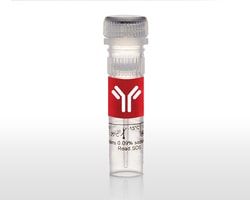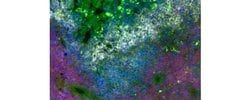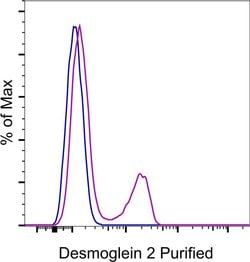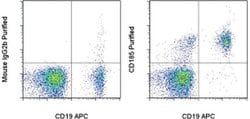14-915-982
Desmoglein 2 Monoclonal Antibody (CSTEM28), eBioscience™, Invitrogen™
Manufacturer: Invitrogen
Select a Size
| Pack Size | SKU | Availability | Price |
|---|---|---|---|
| Each of 1 | 14-915-982-Each-of-1 | In Stock | ₹ 29,726.00 |
14-915-982 - Each of 1
In Stock
Quantity
1
Base Price: ₹ 29,726.00
GST (18%): ₹ 5,350.68
Total Price: ₹ 35,076.68
Antigen
Desmoglein 2
Classification
Monoclonal
Concentration
0.5 mg/mL
Formulation
PBS with 0.09% sodium azide
Gene Accession No.
Q14126
Gene Symbols
DSG2
Purification Method
Affinity chromatography
Regulatory Status
RUO
Gene ID (Entrez)
1829
Content And Storage
4° C, store in dark, DO NOT FREEZE!
Form
Liquid
Applications
Flow Cytometry, Immunocytochemistry
Clone
CSTEM28
Conjugate
Unconjugated
Gene
DSG2
Gene Alias
AA408168; ARVC10; ARVD10; Cadherin family member 5; CDHF5; CMD1BB; D18Ertd293e; desmoglein 2; desmoglein-2; DSG2; DSG-2; HDGC; MGC117034; MGC117036; MGC117037
Host Species
Mouse
Quantity
100 μg
Primary or Secondary
Primary
Target Species
Human
Product Type
Antibody
Isotype
IgG2b κ
Description
- This monoclonal antibody CSTEM28 reacts with human desmoglein 2 (DSG2), a type 1 transmembrane protein belonging to the cadherin family
- DSG2 is expressed by epithelial cells, cardiomyocytes, endothelial progenitors, and CD34+CD45dim hematopoietic stem and progenitor cells
- This adhesion molecule forms cell-cell adhesion complexes called desmosomes that provide tensile strength to tissues that experience mechanical stress
- Other than its role in desmosome formation, DSG2 plays a role in barrier integrity, adhesion, migration, cell apoptosis, proliferation, vasculogenic mimicry, and intracellular signaling
- DSG2-expressing endothelial progenitor cells are pro-angiogenic, suggesting a role in vasculature formation
- On hematopoietic stem and progenitor cells, DSG2 expression is highest on CD38-CD90+ multi-potent cells
- DSG2 expression is progressively decreased as a function of differentiation, with DSG2 expression absent on mature lymphocytes
- DSG2 also serves as a receptor for adenoviruses and can be shed by mucosal barriers in the intestine
- This CSTEM28 antibody has been tested by flow cytometric analysis of the 2102ep cell line
- This has also been tested by immunocytochemistry of fixed and permeabilized cells and can be used at less than or equal to 10 μg/mL
- It is recommended the antibody be carefully titrated for optimal performance in the assay of interest
- Purity: Greater than 90%, as determined by SDS-PAGE
- Desmosomes are cell-cell junctions between epithelial, myocardial, and certain other cell types
- Currently, three desmoglein subfamily members have been identified and all are members of the cadherin cell adhesion molecule superfamily
- These desmoglein gene family members are located in a cluster on chromosome 18
- This protein has been identified as the autoantigen of the autoimmune skin blistering disease pemphigus vulgaris.
Compare Similar Items
Show Difference
Antigen: Desmoglein 2
Classification: Monoclonal
Concentration: 0.5 mg/mL
Formulation: PBS with 0.09% sodium azide
Gene Accession No.: Q14126
Gene Symbols: DSG2
Purification Method: Affinity chromatography
Regulatory Status: RUO
Gene ID (Entrez): 1829
Content And Storage: 4° C, store in dark, DO NOT FREEZE!
Form: Liquid
Applications: Flow Cytometry, Immunocytochemistry
Clone: CSTEM28
Conjugate: Unconjugated
Gene: DSG2
Gene Alias: AA408168; ARVC10; ARVD10; Cadherin family member 5; CDHF5; CMD1BB; D18Ertd293e; desmoglein 2; desmoglein-2; DSG2; DSG-2; HDGC; MGC117034; MGC117036; MGC117037
Host Species: Mouse
Quantity: 100 μg
Primary or Secondary: Primary
Target Species: Human
Product Type: Antibody
Isotype: IgG2b κ
Antigen:
Desmoglein 2
Classification:
Monoclonal
Concentration:
0.5 mg/mL
Formulation:
PBS with 0.09% sodium azide
Gene Accession No.:
Q14126
Gene Symbols:
DSG2
Purification Method:
Affinity chromatography
Regulatory Status:
RUO
Gene ID (Entrez):
1829
Content And Storage:
4° C, store in dark, DO NOT FREEZE!
Form:
Liquid
Applications:
Flow Cytometry, Immunocytochemistry
Clone:
CSTEM28
Conjugate:
Unconjugated
Gene:
DSG2
Gene Alias:
AA408168; ARVC10; ARVD10; Cadherin family member 5; CDHF5; CMD1BB; D18Ertd293e; desmoglein 2; desmoglein-2; DSG2; DSG-2; HDGC; MGC117034; MGC117036; MGC117037
Host Species:
Mouse
Quantity:
100 μg
Primary or Secondary:
Primary
Target Species:
Human
Product Type:
Antibody
Isotype:
IgG2b κ
Antigen: Survivin
Classification: Monoclonal
Concentration: 0.5 mg/mL
Formulation: PBS with 0.09% sodium azide; pH 7.2
Gene Accession No.: O15392
Gene Symbols: Birc5
Purification Method: Affinity chromatography
Regulatory Status: RUO
Gene ID (Entrez): 332
Content And Storage: 4° C
Form: Liquid
Applications: Immunocytochemistry, Immunohistochemistry (Paraffin)
Clone: STLALYV
Conjugate: Unconjugated
Gene: Birc5
Gene Alias: AAC-11; AP14; Api4; apoptosis inhibitor 4; Apoptosis inhibitor survivin; baculoviral IAP repeat containing 5; baculoviral IAP repeat-containing 5; baculoviral IAP repeat-containing 5 (survivin); baculoviral IAP repeat-containing protein 5; BIRC 5; BIRC5; EPR 1; EPR-1; Iap4; inhibitor of apoptosis; survivin; survivin variant 3 alpha; survivin40; SVV; TIAP
Host Species: Mouse
Quantity: 2 mg
Primary or Secondary: Primary
Target Species: Human
Product Type: Antibody
Isotype: IgG2b κ
Antigen:
Survivin
Classification:
Monoclonal
Concentration:
0.5 mg/mL
Formulation:
PBS with 0.09% sodium azide; pH 7.2
Gene Accession No.:
O15392
Gene Symbols:
Birc5
Purification Method:
Affinity chromatography
Regulatory Status:
RUO
Gene ID (Entrez):
332
Content And Storage:
4° C
Form:
Liquid
Applications:
Immunocytochemistry, Immunohistochemistry (Paraffin)
Clone:
STLALYV
Conjugate:
Unconjugated
Gene:
Birc5
Gene Alias:
AAC-11; AP14; Api4; apoptosis inhibitor 4; Apoptosis inhibitor survivin; baculoviral IAP repeat containing 5; baculoviral IAP repeat-containing 5; baculoviral IAP repeat-containing 5 (survivin); baculoviral IAP repeat-containing protein 5; BIRC 5; BIRC5; EPR 1; EPR-1; Iap4; inhibitor of apoptosis; survivin; survivin variant 3 alpha; survivin40; SVV; TIAP
Host Species:
Mouse
Quantity:
2 mg
Primary or Secondary:
Primary
Target Species:
Human
Product Type:
Antibody
Isotype:
IgG2b κ
Antigen: Survivin
Classification: Monoclonal
Concentration: 0.5 mg/mL
Formulation: PBS with 0.09% sodium azide; pH 7.2
Gene Accession No.: O15392
Gene Symbols: Birc5
Purification Method: Affinity chromatography
Regulatory Status: RUO
Gene ID (Entrez): 332
Content And Storage: 4° C
Form: Liquid
Applications: Immunocytochemistry, Immunohistochemistry (Paraffin)
Clone: STLALYV
Conjugate: Unconjugated
Gene: Birc5
Gene Alias: AAC-11; AP14; Api4; apoptosis inhibitor 4; Apoptosis inhibitor survivin; baculoviral IAP repeat containing 5; baculoviral IAP repeat-containing 5; baculoviral IAP repeat-containing 5 (survivin); baculoviral IAP repeat-containing protein 5; BIRC 5; BIRC5; EPR 1; EPR-1; Iap4; inhibitor of apoptosis; survivin; survivin variant 3 alpha; survivin40; SVV; TIAP
Host Species: Mouse
Quantity: 100 μg
Primary or Secondary: Primary
Target Species: Human
Product Type: Antibody
Isotype: IgG2b κ
Antigen:
Survivin
Classification:
Monoclonal
Concentration:
0.5 mg/mL
Formulation:
PBS with 0.09% sodium azide; pH 7.2
Gene Accession No.:
O15392
Gene Symbols:
Birc5
Purification Method:
Affinity chromatography
Regulatory Status:
RUO
Gene ID (Entrez):
332
Content And Storage:
4° C
Form:
Liquid
Applications:
Immunocytochemistry, Immunohistochemistry (Paraffin)
Clone:
STLALYV
Conjugate:
Unconjugated
Gene:
Birc5
Gene Alias:
AAC-11; AP14; Api4; apoptosis inhibitor 4; Apoptosis inhibitor survivin; baculoviral IAP repeat containing 5; baculoviral IAP repeat-containing 5; baculoviral IAP repeat-containing 5 (survivin); baculoviral IAP repeat-containing protein 5; BIRC 5; BIRC5; EPR 1; EPR-1; Iap4; inhibitor of apoptosis; survivin; survivin variant 3 alpha; survivin40; SVV; TIAP
Host Species:
Mouse
Quantity:
100 μg
Primary or Secondary:
Primary
Target Species:
Human
Product Type:
Antibody
Isotype:
IgG2b κ
Antigen: CD185 (CXCR5)
Classification: Monoclonal
Concentration: 0.5 mg/mL
Formulation: PBS with 0.09% sodium azide; pH 7.2
Gene Accession No.: P32302
Gene Symbols: CXCR5
Purification Method: Affinity chromatography
Regulatory Status: RUO
Gene ID (Entrez): 643, 701792
Content And Storage: 4° C
Form: Liquid
Applications: Flow Cytometry
Clone: MU5UBEE
Conjugate: Unconjugated
Gene: CXCR5
Gene Alias: Blr1; Blr-1; Burkitt lymphoma receptor 1; burkitt lymphoma receptor 1 homolog; Burkitt lymphoma receptor 1, GTP binding protein (chemokine (C-X-C motif) receptor 5); Burkitt lymphoma receptor 1, GTP-binding protein; C Cmotif chemokine; C X C motif chemokine; CC motif chemokine; CCmotif chemokine; CD185; CD185 antigen; chemochine (C-X-C motif) receptor 5; chemokine (C-X-C motif) receptor 5; CXC; C-X-C chemokine receptor type 5; CXC motif chemokine; C-X-C motif chemokine receptor 5; CXCR5; CXC-R5; CXCR-5; EGK_06966; Fusin; Gpcr6; GPR9; HUMSTR; LESTR; MDR15; MDR-15; Monocyte-derived receptor 15; neurolymphatic receptor; NLR
Host Species: Mouse
Quantity: 2 mg
Primary or Secondary: Primary
Target Species: Human, Non-human Primate, Rhesus Monkey
Product Type: Antibody
Isotype: IgG2b κ
Antigen:
CD185 (CXCR5)
Classification:
Monoclonal
Concentration:
0.5 mg/mL
Formulation:
PBS with 0.09% sodium azide; pH 7.2
Gene Accession No.:
P32302
Gene Symbols:
CXCR5
Purification Method:
Affinity chromatography
Regulatory Status:
RUO
Gene ID (Entrez):
643, 701792
Content And Storage:
4° C
Form:
Liquid
Applications:
Flow Cytometry
Clone:
MU5UBEE
Conjugate:
Unconjugated
Gene:
CXCR5
Gene Alias:
Blr1; Blr-1; Burkitt lymphoma receptor 1; burkitt lymphoma receptor 1 homolog; Burkitt lymphoma receptor 1, GTP binding protein (chemokine (C-X-C motif) receptor 5); Burkitt lymphoma receptor 1, GTP-binding protein; C Cmotif chemokine; C X C motif chemokine; CC motif chemokine; CCmotif chemokine; CD185; CD185 antigen; chemochine (C-X-C motif) receptor 5; chemokine (C-X-C motif) receptor 5; CXC; C-X-C chemokine receptor type 5; CXC motif chemokine; C-X-C motif chemokine receptor 5; CXCR5; CXC-R5; CXCR-5; EGK_06966; Fusin; Gpcr6; GPR9; HUMSTR; LESTR; MDR15; MDR-15; Monocyte-derived receptor 15; neurolymphatic receptor; NLR
Host Species:
Mouse
Quantity:
2 mg
Primary or Secondary:
Primary
Target Species:
Human, Non-human Primate, Rhesus Monkey
Product Type:
Antibody
Isotype:
IgG2b κ









